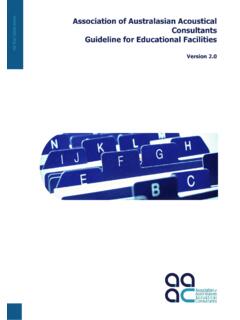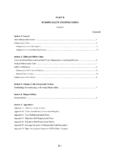Transcription of ProPG: Planning & Noise - ioa.org.uk
1 ProPG: Planning & Noise Professional Practice Guidance on Planning & Noise New Residential Development May 2017. Contents Acknowledgements 03. Foreword 04. 1. Introduction 05. 2. Recommended approach for new residential development 07. 3. Recommendations to the decision maker 24. 4. Further specialist assistance 28. Appendix A: Dealing with Noise events 29. Acknowledgements Acknowledgements The preparation of this Professional Practice The Working Group also acknowledges input Guidance on Planning & Noise (ProPG) was from other individuals including Chris Hurst, Ed overseen by a Working Group consisting of Clarke, and the members of the ANC Acoustics, representatives of the Association of Noise Ventilation and Overheating Group, particularly Consultants (ANC), Institute of Acoustics (IOA) Matthew Hyden and Jack Harvie-Clark, who have and Chartered Institute of Environmental Health all been involved in various stages of this project.
2 (CIEH), together with practitioners from a Planning and local authority background. The final production of this document was The project was jointly supported by the ANC, sponsored by the ANC and undertaken by IOA and CIEH. Ingenious Design supported by Colin Grimwood and Steve Mitchell. This version of the ProPG has been prepared following consideration of comments received during consultation with the wider membership of the three supporting bodies. The support and helpful advice received from members during the consultation stage is gratefully acknowledged. The core members of the Working Group were: Colin Grimwood CJGEM, main author Dani Fiumicelli Temple Group, Chair of Working Group Colin Cobbing Arup Richard Greer Arup Steve Mitchell ProPG Planning & Noise : New Residential Development May 2017. ERM. Graham Parry ACCON UK. Howard Price CIEH. Somayya Yaqub LB Hammersmith & Fulham Robert Osborne ANC, Secretary of Working Group 03.
3 Foreword Foreword This Professional Practice Guidance on Planning The recommended approach detailed in this and Noise (ProPG) has been produced to provide guidance includes a framework to enable practitioners with guidance on a recommended situations where Noise is not an issue to be approach to the management of Noise within the clearly determined, and to help identify the Planning system in England. extent of risk at noisier sites. Higher development costs should invariably be anticipated in those The National Planning Policy Framework (NPPF) areas exposed to high levels of Noise that may encourages improved standards of design. The be harmful or otherwise unacceptable. The CIEH, IOA and the ANC have worked together to recommended approach provides opportunities produce this guidance which encourages better to incorporate effective design interventions that acoustic design for new residential development will enable residential development to proceed in and aims to protect people from the harmful areas that might otherwise have been considered effects of Noise .
4 Unsuitable. Inevitably, there may be some situations where it is not appropriate to build new Good acoustic design is about more than the dwellings. Even in those situations, this guide will numbers. It is a holistic design process that assist as it encourages early identification of the creates places that are both comfortable and risk of refusal and supports early decision making attractive to live in, where acoustics is considered thereby avoiding unnecessary development integral to the living environment. and design costs. Good acoustic design can involve, for example, This guidance is aimed at practitioners rather careful site layouts and better orientation of than the general public and some, though not rooms within dwellings. Good acoustic design expert, knowledge of Planning and acoustics does not mean gold plating or significantly principles is assumed. The document draws upon increasing costs.
5 This guidance seeks to legislation, guidance and standards that were encourage and promote design outcomes that current at the time of publication. are proportionate and reasonable in the particular circumstances of each development site. This Professional Practice Guidance does not The Working Group recognises that whilst constitute an official government code of current Government Planning and Noise policy practice and neither replaces nor provides ProPG Planning & Noise : New Residential Development May 2017. and guidance sets clear objectives it does not an authoritative interpretation of the law or prescribe specific numerical acoustics standards government policy on which users should and it allows a range of different approaches take their own advice as appropriate. to be used. The Working Group believes that the approach encouraged by this ProPG will be suitable in the majority of situations likely to be encountered in practice.
6 The use of this guidance will result in a more consistent approach which should help enable the speedier delivery of new homes. Good acoustic design is about more than the numbers. It is a holistic design process . 04. 1. Introduction 1. Introduction Noise can have a significant effect on (such as dominant Noise from industrial, the environment and on the health commercial or entertainment premises). and quality of life of individuals and and of ground-borne Noise and vibration, communities. Noise can interfere with is outside the scope of this document. residential and community amenity and the utility of Noise -sensitive land uses. This ProPG encourages improvements Noise exposure can lead to a range of in the consistency and quality of plan- adverse effects including sleep disturbance making and decision-taking in relation to and annoyance. There is evidence that acoustic matters. The context is primarily exposure to aviation Noise while at school development control, although some can impair cognitive learning in children.
7 Of the content is relevant to strategic It is also agreed by many experts that Planning . Similarly, although the policy there is an association between long coverage is limited to England, the term exposure to environmental Noise approach may be useful in other parts and chronic health effects. For example, of the UK. associations have been found between long term exposure to transport Noise , The preparation of this ProPG. particularly from aircraft and road acknowledges and reflects the traffic, and an increase in the risk of Government's overarching Noise Policy cardiovascular effects (heart disease Statement for England (NPSE), the National and hypertension). Planning Policy Framework (NPPF) and Planning Practice Guidance (including For these reasons, Noise is a material PPG- Noise ), as well as other authoritative consideration in the Planning process sources of guidance. and a key aspect of sustainable development.
8 Noise must therefore This ProPG provides advice for Local be given serious attention when new Planning Authorities (LPAs) and developers, developments might create additional and their respective professional advisers. Noise and when new developments It aims to complement Government would be sensitive to prevailing acoustic Planning and Noise policy and guidance. conditions. In particular, it strives to: ProPG Planning & Noise : New Residential Development May 2017. The scope of this ProPG is restricted to advocate full consideration of the the consideration of new residential acoustic environment from the earliest development that will be exposed possible stage of the development predominantly (see Section 2) to airborne control process;. Noise from transport sources (noting that encourage the process of good acoustic good professional practice should have design in and around new residential regard to any reasonably foreseeable developments.)
9 Changes in existing and/or new sources outline what should be taken of Noise ). New apartments, flats and into account in deciding Planning houses are the most common type of applications for new Noise -sensitive new residential development, however developments;. the guidance can also be applied to other improve understanding of how to types of residential developments such as determine the extent of potential Noise residential institutions, care homes etc. impact and effect; and Some of the content is relevant to other assist the delivery of sustainable types of Noise -sensitive development development. and to other sources of Noise . However, detailed consideration of other Noise - sensitive development (such as schools and hospitals), other sources of Noise 05. 1. Introduction It is Government policy that Noise should Section 2 outlines a recommended not be considered in isolation or separately approach to the management of from the economic, social and other Noise with respect to new residential environmental dimensions of proposed development within the Planning system.
10 Development. Furthermore, the NPPF The approach involves an initial, and states ( ) that economic, social and relatively simple, risk assessment of the environmental gains from development site to determine the likely importance should ideally be sought jointly and advises of Noise issues. A more detailed second LPAs to seek net gains across all three stage includes a systematic assessment dimensions of sustainable development. of relevant aspects of the development However, there may be circumstances proposal supported by an Acoustic where the development need is such that Design Statement. it outweighs the adverse Noise impacts. Section 3 shows how following this Conversely, unacceptable Noise impacts approach leads the Noise practitioner to may at times override other Planning a choice of one of four recommendations considerations. Recommendations are to the decision maker. A discussion provided in this document on where supporting the approach to dealing with such situations might arise.





